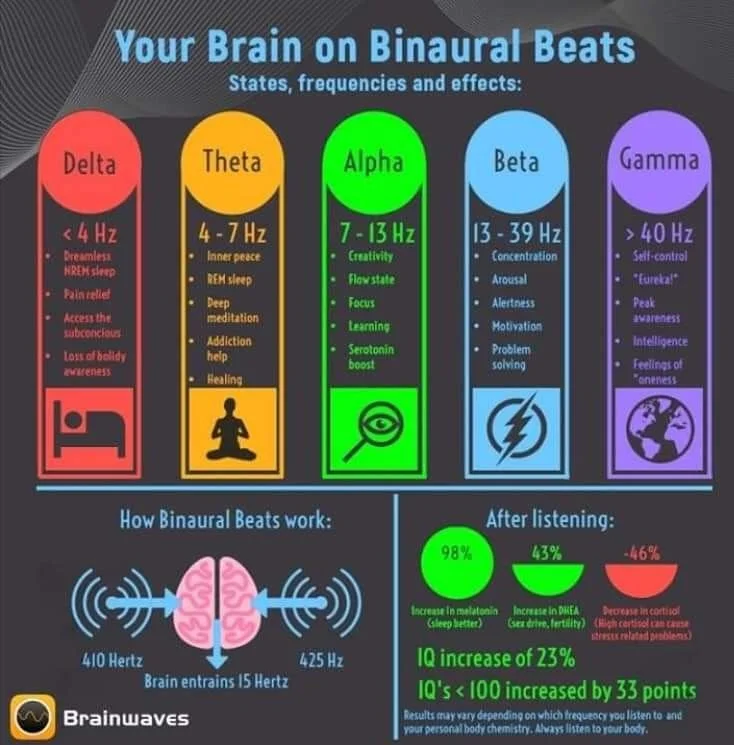The 1839 Brain Hack Hiding in Your Headphones — Binaural Beats, Explained 🎧
TL;DR: In 1839, physicist Heinrich Wilhelm Dove discovered that playing slightly different tones to each ear makes your brain “hear” a third, internal rhythm—the binaural beat. That phantom pulse can nudge brain activity toward calmer, sleepier, or more focused states. It’s not magic, but when used gently (with headphones, low volume, and smart habits), it can help your mind ease into rhythm.
llustration of binaural beats: two tones → internal beat in the brain
A Strange Discovery
Back in 1839, a young German scientist found a curious trick of perception. Feed one ear a 400 Hz tone and the other 410 Hz, and the brain creates a third tone pulsing at 10 Hz—the difference between them.
No speaker plays that beat. Your auditory cortex does.
That illusion, the binaural beat, lay mostly forgotten for decades—until neuroscience and digital audio resurrected it as a potential sleep and focus tool.
Why Your Brain Cares About Beats
Brainwave states and corresponding frequencies — how binaural beats map to them
Your nervous system runs on rhythms—tiny oscillations that change as you move from alert to drowsy to dreaming. When an external rhythm falls within those same frequencies, your brain sometimes syncs—or entrains—to it.
Typical ranges linked to mental states:
StateFrequency RangeVibeDelta (0.5–4 Hz)Deep sleepHeavy calm, body repairTheta (4–8 Hz)Drowsy / meditativePre-sleep driftAlpha (8–12 Hz)Relaxed focusReading, creative flowLow Beta (12–15 Hz)Light alertnessConcentrated work
When the gap between tones matches one of these, your brain may subtly lean in that direction—like rocking a boat until it finds its rhythm.
The Ground Rules
🎧 Use headphones. The effect depends on each ear receiving its own tone. Over speakers, you’ll only get an ordinary acoustic wobble.
🔉 Keep it quiet. The “beat” lives in the gap between tones, not their loudness.
🕓 Time it right. Try ~10 Hz for calm focus or ~3 Hz for pre-sleep wind-down.
🧠 Expect subtlety. Some listeners relax immediately; others feel nothing. It’s normal—brains differ.
Binaural beats aren’t sorcery. They’re just gentle metronomes for your nervous system.
A Beginner’s Nightly Experiment
1. Pick your target.
Wind-down / meditation: Theta (4–7 Hz)
Pre-sleep settling: Delta (1–3 Hz) for 10–20 minutes before bed
Focus block: Alpha/low-beta (10–15 Hz) with broadband noise underlay
2. Layer your sound.
Blend the beats quietly beneath pink or brown noise, rain, or ocean audio to soften the tone and prevent fatigue.
3. Keep the basics intact.
Dim lights 90 min before bed.
Cool the room (60–67°F / 15–19°C).
Anchor your wake time.
Cut caffeine after lunch.
4. Test, don’t guess.
Do a 5-day A/B: two nights as usual, two with binaural beats under pink noise, one control night off. Track sleep latency(how long to doze) and next-day alertness.
If It Doesn’t Click
Potential benefits of binaural beats (relaxation, focus, sleep)
No harm done. Some people prefer:
Isochronic tones (beats produced by rhythmic on/off pulses)
Amplitude-modulated sounds (gentle volume waves)
Or the timeless classics—pink/brown noise, rain, or fans
The goal is constant: build a stable, uninteresting sound field that tells your brain, “Nothing to monitor—stand down.”
The Takeaway
Binaural beats are a 19th-century curiosity turned 21st-century calm tool. Safe to try, best when subtle, and most powerful when paired with good sleep hygiene.
They’re not a shortcut to enlightenment or perfect rest—but for many, they’re a quiet rhythm that helps the mind exhale.
Try the same effect inside Hush — your AI sound designer.
#BinauralBeats #SleepScience #Neurosound #FocusAid #Relaxation #CBTI #SleepHealth #PinkNoise #BrownNoise #SoundSleep #BrainWaves #Entrainment #SleepBetter #Wellbeing #BetterSleepTonight


